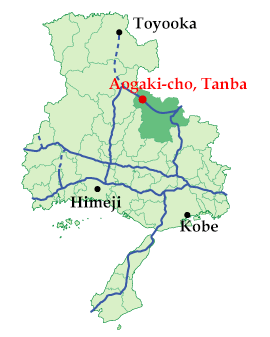About us
Roles of the Wildlife Management Research Center, Hyogo (WMRC)
Serious damage by wildlife and its conservation needs
In Hyogo Prefecture of Japan, conflicts between wildlife and humans have become more serious, such as agricultural damage caused by animals including sika deer, wild boars and monkeys, and scare of attacks by Japanese black bears.
The total amount of agricultural damage almost reaches one billion yen.
The other important issues include conservation of endangered species and measures against increasing alien species.
Towards successful wildlife management
WMRC strives to address issues above and promote the conservation and management of wild animals (Wildlife Management) with the goals and operations described below.
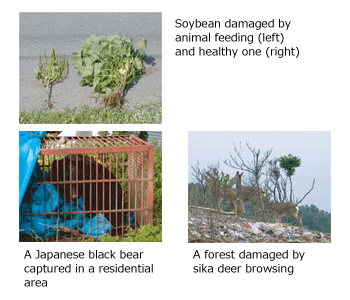
Goals
- Prevention of agricultural damage and wildlife-related injuries of people
- Development of rural areas with abundant natural resources
- Renaissance of environment-friendly local culture to coexist with wildlife
- Sustainable use of natural resources
- Restoration of natural environments, including initiatives to manage habitat in forests
for coexistence and biodiversity conservation
Operations
- Establishment of the WMRC to secure a scientific basis for related activities
- Development of the Wildlife Specialist System to facilitate the policy implementation
- Set up of the Wildlife Management Council to ensure opportunities for public
participation and consensus building
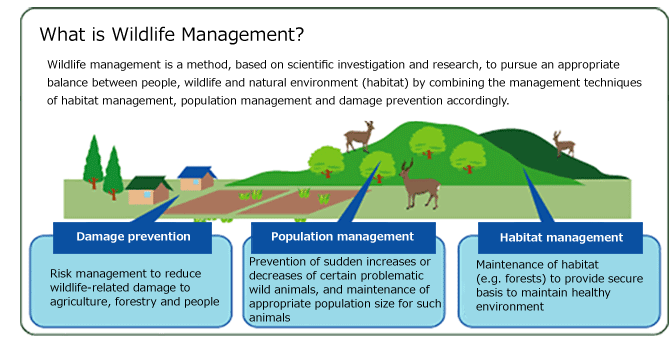
Essential Services of the WMRC
The WMRC provides essential services outlined below.
● Investigation and research on wildlife, habitats, social environment, etc.
We collect, accumulate and analyze scientific data for wildlife management, and provide the public with future projections and policy recommendations.
- Investigation and research on wild animals that attract bigger social attention such as agricultural damage, and endangered species.
- Investigation and research on linkages among wild animals, people, society, rural environment and wildlife habitat including forests
- Investigation and research in pursuit of coexistence through methods including population management, habitat management and damage prevention
● Support for policy planning
We support the government in policy planning, based on our research outcomes and field experiences.
- Clarification of administrative challenges and suggestions of countermeasures to address them
- Provision of data and technical verification required for effective development of the Wildlife Management Plan and the Conservation and Management Plan for a Designated Wildlife Species
- Suggestions of a variety of measures (population management, habitat management, and damage prevention) through cooperation among various stakeholders
● Technical support for on-site operation
We dispatch our qualified Wildlife Specialists and Researchers working together to support government officers-in-charge and people for on-site operations.
- Support for the community initiative to develop resilient communities to wildlife damage, based on the research outcomes.
- Advice on how to repel animals from locations of conflicts, and support for consensus building regarding issues such as rules on how to deal with problematic animals
- Support for habitat management, including forest management to separate zones for people and wildlife
● Human resource development
We develop professional human resources for effective wildlife management, and also raise public awareness of wildlife management issues.
- Training for local government officers at both prefectural and municipal levels
- Development of a good range of hunters and animal-capture technicians in quantity and quality
- Support for wildlife management activities operated by local people and NPOs, and organizing of public seminars
● Provision of information and museum functions
We provide information on wildlife in a variety of ways.
- Collection and provision of information regarding wildlife
- Promotion of the eco museum concept in model areas
- Provision of museum functions including the opening of research sites to the public
Organization
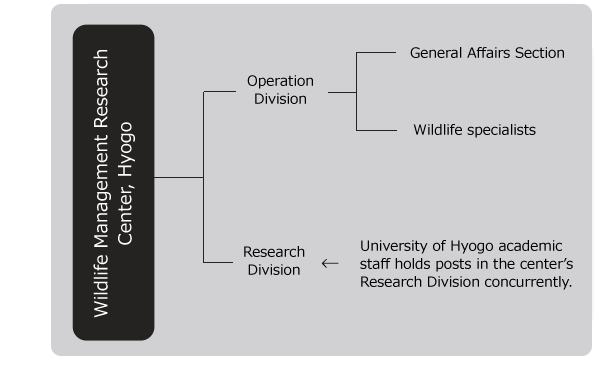
Projects
Our research activities take comprehensive approach with 11 projects, and the outcomes are feed-backed to effective policy implementation.
● Development of resilient communities to wildlife damage
Mitigating wildlife damage in communities requires knowledgeable people to take initiatives for damage prevention and preparedness. The project supports this with effective tools for community training, systematic development of human resources, and establishment of model community in cooperation with stakeholders
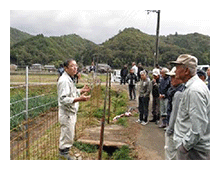
● Habitat management in forest
Forests provide wildlife with habitats, as well as significant public functions for people’s livelihood.
The project develops adaptive management methods to take full advantage of the public functions without disregarding roles of wildlife habitats.
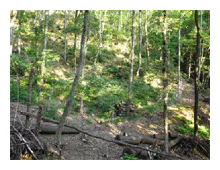
● Adaptive management of overabundant sika deer
Sika deer cause serious agricultural damage and the decline of natural vegetation in the prefecture.
The project monitors sika deer status and the damage, and appropriately manages its population based on the results of the monitoring and analysis.
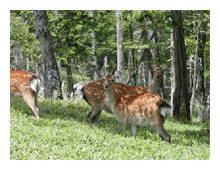
● Prevention of damage by macaques
Agricultural damage by Japanese macaques seriously affects the people’s livelihoods.
The project monitors macaques and develops comprehensive damage prevention measures to meet the community needs. The project also develops damage prevention technologies including new guard fences and repelling by trained dogs.
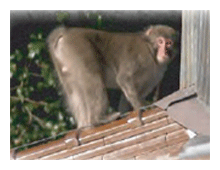
● Prevention of damage by wild boars and conservation of hunting resources
Wild boars cause serious agricultural damage, while provide important hunting resources.
The project develops and promotes methods to mitigate damage while utilizing and conserving them as hunting resources.
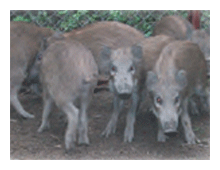
● Conservation of Japanese black bears and risk management in the people’s areas
While sightings of Japanese black bears in people’s residential areas have been an issue, there are concerns over the risk of their local extinction.
The project establishes risk management systems that achieve both damage prevention and its conservation.
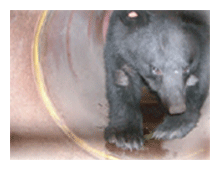
● Measures against alien species
Early action is crucial to secure biodiversity conservation and prevention of agricultural damages in the presence of alien species such as raccoons and nutrias.
The project surveys and identifies their current status, and develops concrete measures against them.
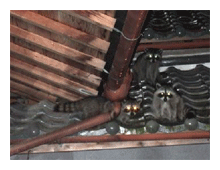
● Effective resource use of wild animals
Wild animals, hunted or controlled as problematic animals, provide important natural resources and should be effectively utilized without wasting it.
The project collects and disseminates information to promote their effective resource use, rural development through appropriate use of wildlife as a gift from nature, and establishment of a society with efficient use of natural resources.

● Conservation of rare wild native species
The project monitors the current status of rare species and develops their conservation measures.
Genetic diversity is also assessed to check their status and stability.
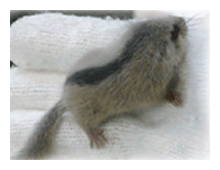
● Risk management of infectious diseases
The project collects and analyzes information on wildlife-related infectious diseases both domestically and internationally to develop risk management measures.
● Human resource development
The project organizes a variety of events including seminars and symposiums, to develop human resources for wildlife management, and to disseminate accurate information on wildlife to the public.
Research Department
Our research interests can be categorized in the six fields as below.
- Forest ecology and habitat management
- Risk management
- Human dimensions
- Wildlife population management
- Applied wildlife ethology
- Wildlife medicine
Investigation/research methods
Field research
- Biological research on wildlife (population density, tracking movement, collection of captured animals, etc.)
- Research on vegetation and natural environments, verification tests for habitat management
- Interviews and questionnaires (status of damage and prevention)
Laboratory experiments and analysis
- DNA analysis, age determination, checking of breeding and nutritional conditions
Data analysis
- Future projections of population trend and damage
- Assessment of extinction risk, etc.
- Assessment of habitat environments
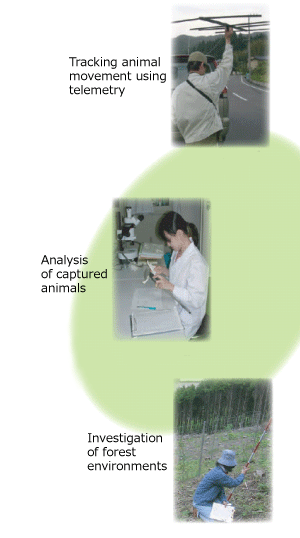
Application of investigation/research outcomes
Technical advices for prefectural policies
- Preparation of a draft Conservation and Management Plan for a Designated Wildlife Species, etc.
- Capture planning and hunting management
- Suggestions for habitat management methods
Support for people’s on-site operations
- Suggestions for effective damage prevention methods
- Advice on what to do for sightings of Japanese black bears, etc.
Provision of information
- Wildlife populations/habitats and actual damage
- Effective measures and methods
- Implementation status of conservation and management
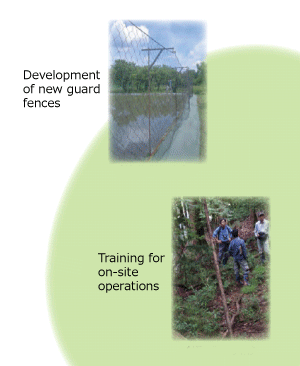
Wildlife Specialist System
The Wildlife specialist system serves a core function to connect research outcomes obtained at the WMRC to actual on-site operations.
In cooperation with researchers and related institutions, wildlife specialists work to solve problems while carefully observing the status and needs of local communities.
Wildlife specialists are stationed at the WMRC, and wildlife instructors are dispatched at every branch office of the Hyogo Prefectural Government (Agriculture and Forestry Promotion Center). These specialists and instructors work together to realize the full functions of the system.
Wildlife specialists
The WMRC employs full-time staff specialized in wildlife conservation and management, and promotes activities across the prefecture.
● Development of resilient communities to wildlife damage
To mitigate damage to agriculture and forestry, wildlife specialists support local community initiatives for damage prevention activities, and raise public awareness. They also support development of resilient communities to wildlife damage through their evaluation and advices on factors and environments in the community that may be attractive to wildlife.
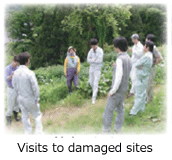
● On-site operations for wildlife encroachmente
Encroachment of wildlife has been a serious problem. Wildlife specialists cooperate and coordinate the stakeholders on-site. These specialists also advise on implementation of bear release with adverse conditioning and community initiative development for repelling.
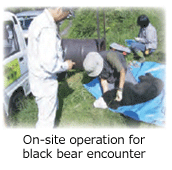
● Comprehensive promotion of conservation and management, toward coexistence with wildlife
Wildlife specialists facilitate the planning, its verification and consensus building among the stakeholders while reflecting the research outcomes of the WMRC into policy development.
Wildlife specialists also organize useful training sessions and seminars to secure and develop human resources for wildlife management throughout the prefecture.

Wildlife instructors
Wildlife instructors are stationed at twelve locations including the prefectural government branch office’s Agriculture and Forestry Promotion Center, and work on habitat management.
● Habitat management in forests
Wildlife instructors provide on-site training for the improvement of core wildlife habitats and buffer zone development to mitigate wildlife encroachment, and a variety of monitoring surveys.
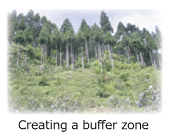
● Advice on damage prevention to forests and forestry
Wildlife instructors investigate damage caused by sika deer to artificial and natural forests and vegetation degradation, and advise how to prevent such damage.
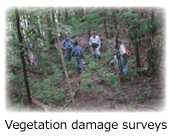
Access & Contact
Contact
Wildlife Management Research Center, Hyogo
Sawano 940, Aogaki-cho, Tanba 669-3842, Japan
Tel: +81-(0)795-80-5500 Fax: +81-(0)795-80-5506
Access
Transportation to the WMRC by car / public transport
- Car: Five min. from Aogaki IC on the Kita Kinki Toyooka Expressway
- Bus: From Kaibara Sta. or Iso Sta. on the JR Fukuchiyama line, take the Shinki bus bound for
Saji/Onaza and get off at Saji bus stop. It is a 20-min. walk from the bus stop. - Bus: Zentan Bus (highway express bus)
From Osaka or Kobe to Kinosaki Onsen or Yumura Onsen
Get off at Aogaki IC. It is a 20-min. walk from the bus stop.
